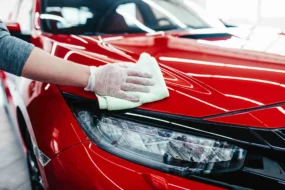The suspension ready for removal of the spring. Make sure the axle stand is placed far enough back to allow removal of the spring and lower-wishbone arm.
If you have to replace a coil spring on the front suspension, the replacement spring must be of the correct rating.
It is also best to replace both front springs — the other one may not match exactly the rating of the new spring to be fitted.
Check the rating with your local dealer. Springs are normally identified by coloured paint markings.
Removing a spring
Raise the car with a jack, and support it on axle stands beneath the frame. Apply the handbrake securely and chock the rear wheels. Remove the raised wheel.
Use a ball-joint separator to split the joint. Do not hammer the joint stud to free it – the threads will be damaged.
Remove the locking pin (if fitted) and unscrew the track-rod ball-joint nut at the steering arm. Disconnect the joint from the steering arm, using a ball-joint separator.
Undo and remove the bolts connecting the tie bar to the lower arm.
Disconnect the anti-roll bar and tie bar, if fitted (See How to replace anti-roll-bar bushes).
On some cars you have to loosen the steering-rack U-clamp bolts and move the rack, to prevent damage to the lower-wishbone fulcrum bolts and the rack gaiters.
With the jack compressing the coil spring slightly, undo the top and bottom damper mountings and withdraw the bolts to free the damper.
On many cars the damper is fitted inside the coil spring, and must be removed. To remove, place a jack beneath the wheel hub and raise it far enough to relieve the loading on the damper.
Release the upper and lower damper mountings and remove the damper through the hole in the lower wishbone. Lower and remove the jack.
Make sure that the hooks on the compressors are firmly seated over the coils of the spring.
Fit the spring compressor clamps opposite to each other on the coils. Tighten them to compress the spring.
Remove the locking pin (if fitted) and the nut from the ball joint at the end of the lower wishbone, where it is connected to the steering swivel member. Separate the joint.
Use a ball-joint separator to disconnect the joint from the steering swivel member.
Tie up the upper wishbone with wire to avoid straining the brake hose. Compress a new spring before fitting.
Tie up the upper wishbone and the steering swivel member (also called the stub axle). Carefully drive out the fulcrum bolt or bolts from the inner end of the wishbone, using a drift of slightly smaller diameter.
Take a note of the way these bolts are fitted, and also of any rubber insulators or cups fitted at the top of the spring, to aid reassembly.
Unscrew the spring compressor clamps a little at a time on each side to release the tension.
When all the tension in the spring has been released, remove the spring from the lower wishbone.
Fitting the new spring to the wishbone
The top coil of the spring may be flattened. Be sure to fit the new spring in the same way.
The top coil of the new spring may be different in shape from the bottom coil. Be sure you insert it right side up.
Compress the new spring with the spring compressor clamps, and place it on the lower wishbone. Make sure the bottom of the spring is seated properly. Reconnect the lower-wishbone ball joint to the stub axle, screwing the nut until finger tight.
Make sure the top of the spring is seated properly and that any rubber cups or insulators have been properly inserted. Reconnect the inner ends of the wishbone with the fulcrum bolt(s).
The wishbone will be easier to refit if the bushes are smeared with petroleum jelly. (Do not tighten the fulcrum bolts fully until the car has been lowered to the ground at a later stage when its weight is on all four wheels.)
Remove the spring compressor clamps carefully. Reconnect the track rod and ball joint and the anti-roll bar or tie rod, if fitted.
If necessary, retighten the steering-rack U-clamp bolts and replace the damper inside the spring.
Make sure that all nuts and bolts are fitted correctly and tightened to the correct torque as recommended by the car maker. Consult a service manual for the car, or your local dealer if necessary.
Use new split pins to lock the ball-joint retaining nuts in place.
Replace the road wheel, lower the car to the ground and tighten the fulcrum bolt(s) fully.







